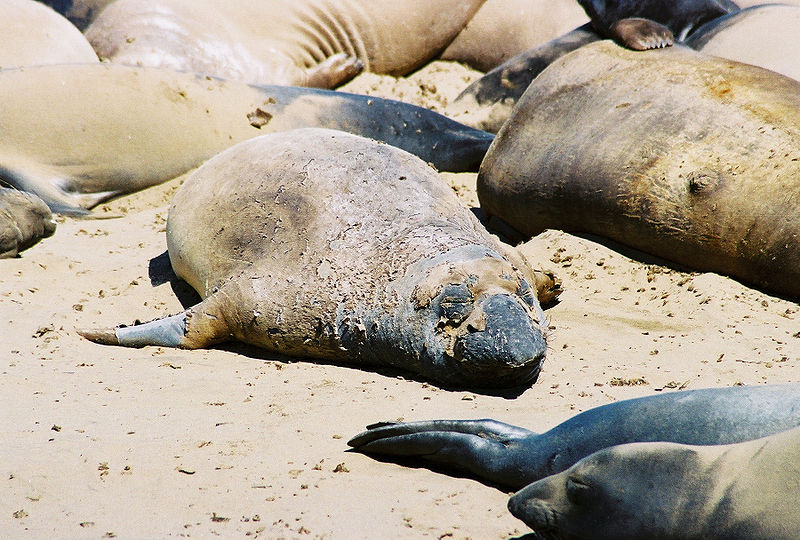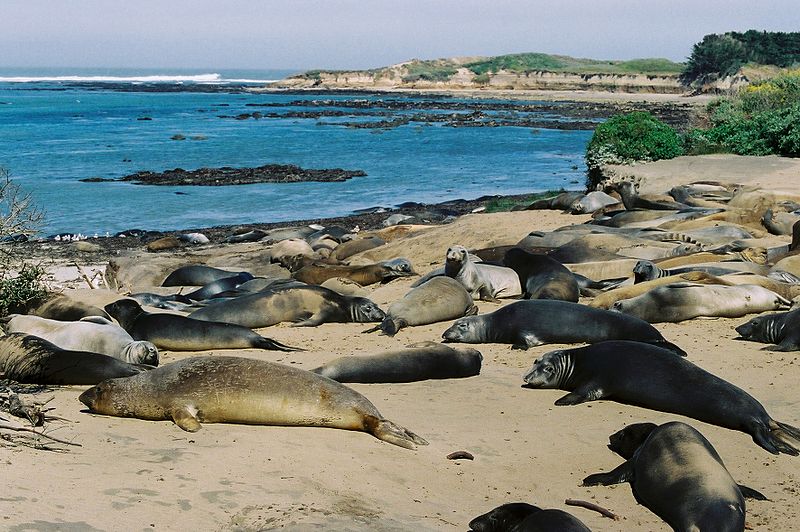
It’s not pretty. An elephant seal molts at Ano Nuevo State Park. Photo by Wikimedia user MonicaSP54.
The elephant seals are back at California’s Año Nuevo State Park. But this is not their famous January breeding season, replete with cute newborn seals and brutal fights between males. Nope, this time they’re here to molt. The seals spend their month on land laying around the beach, languishing in the sun while giant patches of skin and hair fall off into the sand. It’s a sight (and smell) that may be enough to keep tourists away.
But not scientists.
Each time the seals return to shore, marine biologists at UC Santa Cruz rush to nab skin samples, retrieve sensors, and collect any data offering a glimpse of the seals’ offshore lifestyle. The molt may not be pretty for sightseers, but it’s a gold mine for science.
Elephant seals spends most of the year in the ocean, roaming all over the north Pacific. In December they start to come ashore at Año Nuevo, between Santa Cruz and San Francisco, for a month-long mating and breeding season. They then return to the ocean for a mini-feeding frenzy. Seals eat almost constantly when they’re in the water, says Patrick Robinson, director of UC Santa Cruz’ Año Nuevo Island Reserve. When it’s time to shed their winter coat, the seals once again return to land. Molting is an intense process for the seals. Skin and hair fall off in patches as large as a washcloth. Scientists call it a “catastrophic molt.”
“They look kind of horrendous,” Robinson says, comparing the molt to a big, peeling sunburn. Underneath the shed skin, though, the seals display a sleek, shiny summer coat.”Once they’re done they look quite nice,” Robinson says, “but in the process it looks like they’re dying.”
Robinson and other scientists in Daniel Costa’s lab use the dead skin to piece together the seals’ life history. During the animals’ marine excursions, the team tracks the seals’ locations via satellite. But radio data doesn’t tell what the seals are eating. To answer that question, the team is relying on the adage “you are what you eat.” Animals at different levels of the food chain contain different amounts of stable (non-radioactive) carbon and nitrogen isotopes. By analyzing the levels of isotopes in the seals’ shed skin, researchers find clues to where in the ocean – and where in the food chain – the seals are dining. (A similar technique has been applied to great white sharks – one of the elephant seals’ prime predators). Blubber samples yield fatty acids which can be compared against a library of fish fat chemistry, further filling in the seals’ culinary preferences.
Samples of the seals’ hair also serve as a measure of ocean pollution. The UCSC team is beginning to analyze hair for trace concentrations of mercury, flame retardants, and other pollutants that the seals may have encountered on their circuitous travels.
Why so much focus on elephant seals? They’re approachable, Robinson says. “They’re fairly docile. They don’t startle easily.” His team can count on the animals to remain mostly motionless on the beach for a month at a time, twice a year. But it takes a certain olfactory fortitude to walk up to an elephant seal. “The smell is quite ripe out there,” he says.
Robinson says the seals will stay at the reserve, on California’s Highway 1, until mid-June, when they’ll embark on a long-range fall fishing trip. With their new coat of fur, the seals will have plenty of room to nearly double their size before winter as they gobble their way through blue Pacific waters.
See the seals on a live, high-definition webcam here: http://www.parks.ca.gov/?page_id=25732
Hear their unique calls, barks, squawks and grunts here: http://www.parks.ca.gov/?page_id=1116
